Stuart Jeanne Bramhall's Blog: The Most Revolutionary Act , page 369
September 11, 2023
Can Diet Reduce Hearing Loss?
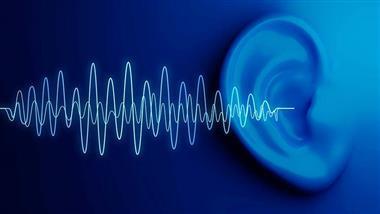
Dr Mercola
Story at-a-glanceLoss of cholesterol in the inner ear may be involved in age-related hearing loss — and phytosterols may help resolve itPhytosterols, which have a structure and function similar to cholesterol, led to improvements in the function of outer hair cells in the inner ear, which help amplify soundsThey may help balance cholesterol in the inner ear, which may be a useful strategy to prevent or delay hearing lossFinally, phytosterols also have anti-inflammatory and anticancer activities and may target neuroinflammation and neurodegenerationEarly humans ate phytosterol-rich diets, consuming as much as 1 gram per day, but the typical modern U.S. diet is relatively low in these beneficial plant-derived compoundsLoss of cholesterol in the inner ear may be involved in age-related hearing loss — and phytosterols, a common over-the-counter supplement, may help resolve it. The finding, published in PLOS Biology, could be “an innovative therapeutic strategy in preventing and/or delaying hearing loss,” the team suggests.1
Age-related hearing loss, also known as presbycusis, affects about 1 in 3 U.S. adults between the ages of 65 and 74. By age 75, close to half of adults may have hearing problems.2 Typically, the loss is gradual, so you may not notice it until the hearing difficulty becomes severe. Phytosterols, which have a structure and function similar to cholesterol,3 may be one option to help slow hearing loss that may occur due to aging.
Low Cholesterol in the Ear Linked to Hearing ProblemsCholesterol plays an important role in the function of neural cell membranes and their associated proteins. It binds to and conditions multiple protein complexes and, in the central nervous system, is involved in synapse formation, interactions between cells and intracellular signaling. Maintaining optimal cholesterol levels in the brain is therefore intricately involved in brain health. According to the PLOS Biology study:4
“Importantly, all cholesterol within the CNS is synthesized in situ due to the fact that peripheral cholesterol cannot cross the blood–brain barrier. Thus, cholesterol levels need to be tightly regulated in the brain, and disruption of cholesterol homeostasis has been linked to cognitive dysfunction and to the development of neurodegenerative diseases.”
It’s also known that cholesterol levels in the brain’s hippocampus may decline with age, affecting cell function, leading the researchers to hypothesize that cholesterol deficiency in the ear may also have ill effects.
Outer hair cells (OHCs) in the inner ear use electromotility to change their length, helping to amplify sounds. Electromotility involves the motor protein prestin, but with increasing age, OHCs may not stretch properly when sounds occur, preventing sound amplification and contributing to difficulty hearing.5 A lack of cholesterol may help explain why:6
“The organization of the OHC lateral wall is exclusive among hair cells and other mammalian cell types because it contains a tightly regulated level of cholesterol. It has been postulated that alterations in the cholesterol content in the OHC lateral wall might modulate the function and/or distribution of prestin within the plasma membrane.”
The team measured the amount of cholesterol 24-hydroxylase (CYP46A1), a brain-specific enzyme that breaks down cholesterol, in inner ear OHCs in mice, finding more of it — and therefore less cholesterol — in older mice compared to younger mice. Further, when CYP46A1 was over-activated with a drug — the antiretroviral efavirenz, used to treat HIV — in young mice, it also led to hearing loss.7
According to the researchers, “Our results show that cholesterol levels in the inner ear are reduced during aging, an effect that is associated with an increased expression of the cholesterol 24-hydroxylase (CYP46A1), the main enzyme responsible for cholesterol turnover in the brain.”8
Phytosterols Reversed Hearing LossThe team then wanted to find out if increasing cholesterol in the brain could reverse the hearing loss caused by the CYP46A1-activating drug. Since cholesterol cannot cross the blood-brain barrier (BBB), they gave young mice phytosterols, which are structured similarly to cholesterol, and can cross the BBB, instead.
Mice given the CYP46A1-activating drug and phytosterols for three weeks had improvements in OHC function. “Strikingly, phytosterols supplementation increased the levels of prestin in the OHCs with an apparent recovery of the normal prestin distribution in the lateral wall,” the team explained.9
“Our findings show for the first time the importance of cholesterol homeostasis in the inner ear as a pharmacotherapeutic strategy to prevent and/or delay hearing loss.”10
Phytosterols Have Anti-Inflammatory, Anticancer EffectsIn addition to influencing the rates at which cholesterol is absorbed, biosynthesized and excreted,11 phytosterols have anti-inflammatory activities and may target neuroinflammation and neurodegeneration.12
The U.S. Food and Drug Administration even endorses the consumption of phytosterols, stating in a 2019 revision to the Code of Federal Regulations, “Scientific evidence demonstrates that diets that include plant sterol/stanol esters may reduce the risk of [coronary heart disease].”13
They may also have anticancer effects, and it’s estimated that eating a phytosterol-rich diet may lower cancer risk by 20%. A review published in Biomedicine & Pharmacotherapy detailed the many ways that phytosterols may act as natural anticancer agents:14
“Phytosterols may … affect host systems, enabling antitumor responses by improving immune response recognition of cancer, affecting the hormone dependent endocrine tumor growth, and by sterol biosynthesis modulation. Moreover, phytosterols have also exhibited properties that directly inhibit tumor growth, including reduced cell cycle progression, apoptosis induction, and tumor metastasis inhibition.”
While it’s believed that early humans ate phytosterol-rich diets, consuming as much as 1 gram per day, the typical U.S. diet is relatively low in these beneficial plant-derived compounds.15 It’s estimated that modern humans eat between 150 and 450 milligrams (mg) of phytosterols per day, depending on diet.
Vegetarians and vegans may have generally higher intakes, as phytosterols are found in all plant foods.16 Some good food sources of phytosterols include:17
OrangesBrussels sproutsPomegranates and pomegranate seed oilCeleryBroccoliOnionsTangerinesMangosCauliflowerRomaine lettucePeasAge-Related Hearing Loss Is Linked to DementiaAge-related hearing loss doesn’t typically exist in a bubble — it’s strongly associated with accelerated cognitive decline and risk of dementia in older adults18 This, too, may have a low cholesterol connection. According to the PLOS Biology study:19
“Several works have demonstrated a reduction in cholesterol levels in the hippocampus during aging, leading to a profound effect on the plasma membrane structure and cell function. Reduced cholesterol content in the aged brain and in neurodegenerative diseases was also reported in humans’ brain samples.
Among the causes for age-associated cholesterol loss, an increase in the levels of the cholesterol-hydroxylating enzyme CYP46A1 in the hippocampus, associated with oxidative stress accumulation, has been proposed … Interestingly, restoring brain cholesterol levels can rescue biochemical, synaptic, and cognitive deficits of aged mice and in a mouse model of Huntington’s disease.”
Lower levels of low-density lipoprotein (LDL) cholesterol are also linked to a higher risk of dementia, as is the use of statin cholesterol-lowering drugs. One study found that people with early mild cognitive impairment and low to moderate cholesterol levels at the start of the study who used lipophilic statins had more than double the risk of dementia compared to those who did not use statins.20
Lipophilic statins, such as atorvastatin (Lipitor), simvastatin (Zocor), Fluvastatin (Lescol), and lovastatin (Altoprev), dissolve more readily in fats21 and can easily enter cells22 and be distributed throughout your body.
The subjects also had significant decline in metabolism of the brain’s posterior cingulate cortex, which is the brain region that declines most significantly in early Alzheimer’s disease.23 Cholesterol, in fact, has many ties to brain health:24
Decreasing cholesterol levels in the elderly may be associated with cerebral atrophy, which occurs with dementiaHigh LDL cholesterol may be beneficial by reducing neurons’ impairments or helping repair injured neuronsAcceleration of neurodegeneration has occurred when neurons where short on cellular cholesterol or cholesterol supplyCholesterol plays an important role in the synthesis, transportation and metabolism of steroid hormones and lipid-soluble vitamins, and both of these are important to synaptic integrity and neurotransmissionWhat Else Contributes to Hearing Loss?Cholesterol is just one factor that may be involved in hearing. Other nutrients, including a lack of vitamins A, B, C, D and E, as well as zinc, magnesium and selenium, may also play a role.25 Researchers with Hanyang University in Korea explained in the journal Nutrients:26
“Antioxidants such as vitamins, which inhibit the formation of free radicals, may play a specific role in preventing and treating HL [hearing loss]. Therefore, several studies have been reported on the relationship between HL and vitamins A, C, and E in humans. Magnesium (Mg) has also been reported to reduce HL through synergistic effects with vitamins.
These findings suggest that free radical scavengers, such as vitamins A, C and E, act in synergy with Mg to reduce changes in hearing thresholds more reliably than treatment with any single agent. Therefore, higher intake of antioxidants and/or magnesium may be associated with a lower risk of HL. Selenium (Se) may also play a role in hearing. Moreover, a lack of vitamin B has been reported to increase the risk of HL.”
Exposure to loud noise, including noise pollution, also contributes to hearing loss over time. The PLOS Biology team explained that a lifetime of loud noise exposure even exacerbates and may trigger age-related hearing loss. “The high level of noise exposure in modern society makes presbycusis a mixture of acquired auditory stress, trauma and otological disease superimposed upon an intrinsic aging process.”27
Unsafe listening practices in young people using personal listening devices (earbuds) and attending loud venues also increase their risk of hearing loss, which one study estimates may affect more than 1 billion 12- to 34-year-olds worldwide.28
Noise pollution, which can come from heavy traffic, construction machinery, loud music, leaf blowers and countless other sources, is another common risk factor. It’s estimated that 10 million Americans have permanent hearing loss due to noise pollution or noise-related trauma.29
In addition to eating well, including a nutrient- and phytosterol-rich diet, you can help protect your hearing and prevent age-related hearing loss by avoiding loud noises as much as possible, reducing your exposure to loud sounds, including music, and wearing protective earplugs or earmuffs when using loud equipment, such as a lawnmower.30
[…]
Via https://articles.mercola.com/sites/articles/archive/2023/09/11/vitamin-hearing-problems.aspx
Scientists Discover Microplastics in Heart and Brain Tissues
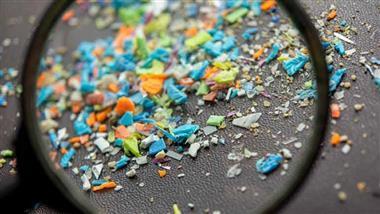
Dr Mercola
Story at-a-glanceDiscarded plastic — both large and microscopic — circles the globe, choking our oceans and polluting our food supply, ultimately finding their way into your body where they can accumulate over timeScientists have detected microplastic in all kinds of human tissues, including the placenta, lungs, spleen, liver, kidney, heart, brain and stool. In 2022, Dutch scientists also confirmed the presence of microplastics in meat and milk, as well as the blood of both farm animals and humansAustrian researchers found plastic microparticles migrate into the brains of mice within two hours of drinking water contaminated with microplastic. Once in the brain, these plastic microparticles can increase the risk of inflammation, neurological disorders or neurodegenerative diseases such as Alzheimer’s. Other recent research found it can trigger behavioral changes akin to dementia in as little as three weeksMicroplastics are toxic to cells. Research shows microplastic particles enter cells within 24 hours of exposure and primarily accumulate around the nucleus of the cell. As levels of microplastics and exposure time increase, cell viability significantly decreasesChinese scientists discovered microplastics in the heart tissue of 15 patients undergoing cardiovascular surgery, and some of this plastic appears to be introduced during the surgery itselfWe live in a throwaway society. The next time you’re in a grocery store, take a look around you and note the number of items packaged in plastic. The problem is, many of these petroleum-based plastics will last forever. So we have products for short-term consumption packaged in materials that survive for centuries, endangering wildlife and human health alike all the while.
Discarded plastic — both large and microscopic — circles the globe, choking our oceans and polluting our food supply, ultimately finding their way into your body where they can accumulate over time. In recent years, scientists have detected microplastic in all kinds of human tissues, including the placenta,1 lungs, spleen, liver, kidney, heart, brain2 and stool.
In 2022, Dutch scientists also confirmed the presence of microplastics in meat and milk, as well as the blood of both farm animals and humans.3,4 In all, nearly 80% of meat and dairy products tested contained microplastics. Shockingly, it was revealed that many feed producers will use expired food products in their processing — with the plastic packaging left on!
Microplastic Rapidly Enters Your BrainIn May 2023, The Guardian reported5 on Austrian research,6,7 which found plastic microparticles migrated into the brains of mice within two hours of drinking water contaminated with microplastic.
“Using computer models to track the dispersion of the plastics, researchers found that nanoplastic particles — which are under 0.001 millimeters and invisible to the naked eye — were able to travel into the mice’s brains via a previously unknown biological ‘transport mechanism,’” The Guardian wrote.
“Essentially, these tiny plastics are absorbed into cholesterol molecules on the brain membrane surface. Thus stowed away in their little lipid packages, they cross the blood-brain-barrier — a wall of blood vessels and tissue that functions to protect the brain from toxins and other harmful substances.”
Once in the brain, these plastic microparticles “could increase the risk of inflammation, neurological disorders or even neurodegenerative diseases such as Alzheimer’s or Parkinson’s,” the researchers warned, and these concerns were recently echoed by scientists at the University of Rhode Island.
Microplastics Trigger Dementia-Like Behavioral ChangesThe research, published in the August 2023 issue of the International Journal of Molecular Sciences,8 showed that microplastics extensively infiltrate the body, including the brain, and can trigger behavioral changes akin to dementia in as little as three weeks.
Here, young and old mice (4-month-olds and 21-month-olds) were exposed to varying levels of microplastics in their drinking water for three weeks. During behavioral testing at the end of the three weeks, many of the animals were found to exhibit dementia-like behavior.
The changes were more pronounced in older animals, which the researchers theorized might be due to “age-related dysfunction exasperating the effects of the PS-MPs [polystyrene microplastics] on behavioral performance.” Lead researcher Jaime Ross called the finding “striking,” because “These were not high doses of microplastics.”
[…]Microplastics May Speed Onset of Neurodegenerative DiseaseAs explained in the paper,10 GFAP is found in mature astrocytes (cells found in your brain and spinal cord), and is involved in cellular processes such as autophagy, neurotransmitter uptake and astrocyte development. GFAP is commonly used as a marker for neuroinflammation.
Oddly enough, GFAP levels were slightly lower in the mice that had been exposed to microplastics, compared to controls, which is atypical if inflammation is part of the problem.
However, the authors pointed out that previous studies have found that “GFAP expression might decrease in early stages of certain diseases, such as Alzheimer’s disease, or in younger patients with disorders such as Major Depressive Disorder.”
Such studies suggest that “early pathology/early onset of disease may be characterized by astrocyte atrophy (as opposed to astrocyte hypertrophy later on), which may result in decreased GFAP expression.”
Microplastics Are Cytotoxic and Boost InflammationThe International Journal of Molecular Sciences paper11 also concluded that microplastics are cytotoxic, which means they’re toxic to cells. The microplastic particles were found to enter cells within 24 hours of exposure, and primarily accumulated around the nucleus of the cell. And, as levels of microplastics and exposure time increased, cell viability significantly decreased.
They also found alterations in immune markers. For example, expression of tumor necrosis factor (TNF-a), an inflammatory cytokine, was two-fold higher in the livers of exposed mice, compared to unexposed controls.
Weathered Plastic Triggers More Severe Inflammatory ResponseIn another recent experiment, researchers looked at the impact of weathered microplastics on human brain cells, compared to brand-new plastic, showing microplastic that has been degraded by environmental exposure causes a more severe inflammatory response.
[…]
This could have important implications for human health, considering a significant portion of the microplastic we consume is through food. Plastic trash in the oceans degrade into microplastic through photosynthesis (exposure to the sun), and those bits are then consumed by fish that end up on our dinner plates.
Microplastics Accumulate in Your Blood and HeartChinese scientists also recently discovered microplastics in the heart tissue of 15 patients undergoing cardiovascular surgery.14
[…]
The following graphic showing where the various plastic particles were found, and their potential sources, was published by the New York Post, August 12, 2023.16 While this study did not theorize about plastic’s contribution to heart disease, considering its impact on inflammation and cell viability, it’s certainly feasible that it could be a contributing factor.
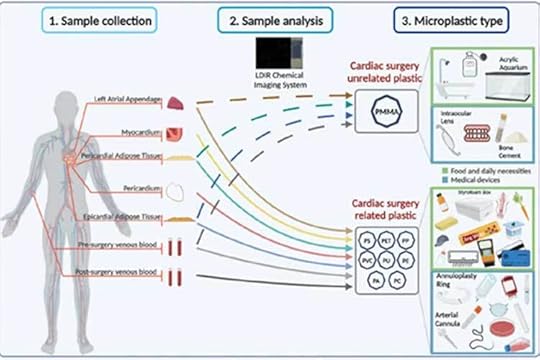 Plastic Exposure Adds Up
Plastic Exposure Adds UpIn late 2020, research by the World Wildlife Federation International estimated that the average person consumes about 5 grams of plastic every week, which is about the weight of a credit card.17
In the average lifetime, a person will consume about 40 pounds of microplastic. While much of this will pass through you, some will remain and accumulate in your organs.Over time, that really adds up. According to the WWF’s calculations,18 each month, you consume about 21 grams, or the equivalent of one Lego brick. In a year’s time, you’ve consumed 250 grams, or the size of a full dinner plate’s-worth of plastic.
In 10 years, you’ve ingested some 5.5 pounds, and in the average lifetime, a person will consume about 40 pounds. While much of this will pass through and be eliminated through your stool, some will remain and accumulate in your organs.
How to Lower Your Microplastic ExposureConsidering much of the microplastic in your body comes from food and water, it would be wise to use a high-quality water filtration system for your home, and opt for organic grass fed and grass finished meats whenever possible.
Avoid any meats or animal products from livestock (or farmed fish) that have been fed feed pellets, as these can contain microplastic from food packaging that have been processed in. Also, try to reduce your plastic consumption and generation of plastic trash in general.
[…]
Via https://articles.mercola.com/sites/articles/archive/2023/09/11/microplastics.aspx
US Plunder of Syria Continues as Convoys Smuggle 95 Tankers’ Worth of Crude From Country

AFP 2023 / DELIL SOULEIMAN
Ilya Tsukanov
The United States operates about a dozen illegal military bases in Syria, most of them concentrated in energy and food-rich areas of the country east of the Euphrates, which contain about nine-tenths of the war-torn nation’s oil and gas resources. Damascus estimates total damage to its hydrocarbons industry of over $100 billion.
Sources in the al-Yaroubia countryside in al-Hasakah province told local media Sunday that 40 tankers of crude oil were shipped to Iraq from the al-Jazeera oil fields using the illegal Mahmoudiya border crossing.
The sources also said that a separate convoy of 55 oil tankers, also from the al-Jazeera fields, was smuggled through the same crossing within the same 24-hour window.
The Damascus government has not been able to reestablish control over most of its oil-rich northeastern territories and its border with western Iraq, with the area under occupation by US forces and their Kurdish-majority ‘Syrian Democratic Forces’ militia allies, which have set up de-facto self-rule over the region. US forces have threatened to respond to any attempt by the Syrian Army and its allies to reestablish control over the country’s lands with overwhelming force.
The US and the SDF have plundered billions of dollars-worth of oil from eastern Syria over the course of the Pentagon’s seven-year occupation of the region going back to 2016, when US forces helped local Kurdish militias chase Daesh (ISIS)* terrorists out.
Syrian officials, Russia’s military and Iran’s Revolutionary Guards Quds Force commanders have accused the US of secretly assisting, training, arming and financing jihadist militias in a bid to sow chaos and wage a never-ending dirty war against the government of President Bashar Assad after failing to oust him during the 2011 ‘Arab Spring’ protests which swept much of the region.
Last week, A’ed al-Helali, a member of the Fattah Alliance in Iraq’s parliament, accused Washington of continuing its occupation and plunder of Syria specifically to finance local terrorists. “The US is not wasting money from its own budget, but is trying to find other outlets to obtain it in order to finance terrorist groups, which is what it is doing with the Syrian oil. The presence of US forces in the Syrian eastern Euphrates region is supporting these groups,” al-Helali said in an interview with local media.
The Biden administration has generally refrained from commenting on its Syrian oil smuggling activities, assuring that the US’s illegal presence in the country is designed only to prevent a resurgence of Daesh.
President Trump was more open about US plans, saying repeatedly in 2018 and 2019 (to the horror of the deep state establishment) that American troops were stationed in Syria “only for the oil.” Assad praised Trump for at least being an “honest enemy.”
The Childhood Vaccination Schedule Starting with Hepatitis B
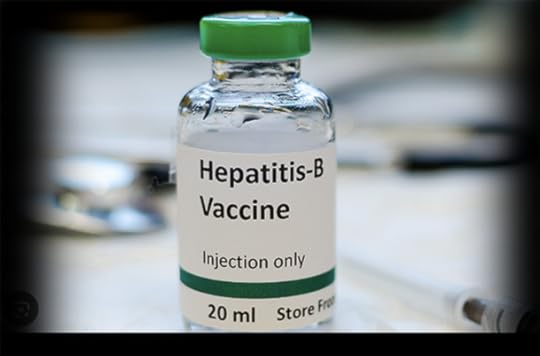
Michael Bryant
21st Century Wire
[…]
In the conventional narrative it is accepted as an article of faith that vaccines are miraculous discoveries responsible for global disease eradication and are the most important medical product for disease prevention.
[…]
It is widely believed that if we stopped, or even reduced vaccinations, we would be going back to the dark ages. Any individual that challenges this vaccine orthodoxy is seen as a heretic.
[…]
The United States Childhood Immunization Schedule – An Overview
In the past few decades the childhood vaccine schedule in the United States has exploded into what is now the most aggressive childhood vaccination schedule in the world. It wasn’t always this way. Most baby boomers likely had only 2 or 3 vaccinations- polio, smallpox and DTP with never more than one shot given per visit.
With the recent addition of the COVID-19 vaccines to the childhood schedule the number of recommended injections ballooned to a regimen of 72 injections of 90 antigens by age eighteen for any child that undergoes the full immunization schedule circa 2023.
[…]
The first vaccine mandate in the United States was enacted in Massachusetts in 1810 and was centered on smallpox. The legislation was essentially an ad hoc law which gave local health boards the authority to require vaccination.
The first public school mandate was issued in Massachusett in the 1850’s. At that time the only vaccine of interest was for smallpox. By the end of the 1800s most states in New England had smallpox vaccine requirements for children attending public schools.
The next significant stride in vaccine recommendations and requirements for children would arrive a century later in 1954, focusing on the polio vaccine developed by Jonas Salk.
[…]
The 1960s and 1970s saw a wave of new vaccines hit the market. A second type of polio vaccine was developed along with the first Hepatitis B vaccine. Measles vaccines were developed as a single vaccine and then combined with the mumps and rubella vaccines to create the “MMR” vaccine.
[…]
By 1977, the U.S. federal government had set up the Childhood Immunization Initiative which sought to increase vaccination rates in children against seven diseases (diphtheria, measles, mumps, pertussis, poliomyelitis, rubella, tetanus) for which vaccines had been developed. This began the process by which all 50 states would adopt mandatory school vaccinations.
In the 1980s, vaccines against Hepatitis B, Haemophilus influenzae type b, and pneumococcal disease were recommended for children at different ages. By 1983 the number of recommended injections had increased to 23 doses of 7 vaccines by age six.
In 1986, the National Childhood Vaccine Injury Act created a system of passive and active surveillance for cases of adverse reactions to vaccines as well as a mechanism to compensate any persons injured by vaccines.
With the passage of the 1986 Act and its implementation in 1988, a liability shield for pharmaceutical companies was created. On the heels of the 1986 Act the number of vaccines placed on the CDC schedule would escalate.
[…]
This dizzying array of injections in the childhood immunization schedule begins on a child’s first day of life with the Hepatitis B vaccine.
Hepatitis B – The Disease: A Case Study In Manufacturing Public Perception
The first question every parent should ask when considering the Hepatitis B vaccine is, “Does my child need a vaccine for Hepatitis B on the first day of life?”
Given the low risk of newborns acquiring the HepB infection and the ease with which pregnant mothers can be screened it’s fair to ask why a newborn would need the HepB vaccine?
[…]
The risk groups listed are, “injection drug users, homosexual men, sexually active heterosexuals, infant/children of immigrants from disease-endemic areas, sexual/household contacts of infected persons, infants born to infected mothers, health care workers and hemodialysis patients.”
What was it that changed the CDC’s earlier 1982 recommendation, which targeted only a small “at-risk” population, into a set of more aggressive policies that would result in the 1991 recommendation that all infants get three doses of HBV by 18 months of age?
And how did the HepB vaccine become compulsory for all schoolchildren in 47 states by the year 2000 even as the CDC admits that they lack proof of HepB being transmitted in a school setting?
[…]
In 2017 the Informed Consent Action Network (ICAN) received a tip from a supporter that the clinical trials used by the FDA to license the two children’s HepB vaccines, Engerix-B and Recombivax HB, only reviewed safety data for a few days after injection.
[…]
Dangers of the HepB Vaccine- An Open Secret
In the first months of life a child’s brain and biological systems are at critical stages of development.
[…]
To the extent that Hepatitis B is a danger to anyone, that risk is understood to be through sexual contact or sharing needles. A sexually transmitted risk or a needle exchange risk means there is little to no chance of Hepatitis B infection for infants calling into question the fundamental rationale for this vaccine.
[…]
In a 2013 study, Aluminum in the Central Nervous System: Toxicity in Humans and Animals, Vaccine Adjuvants, and Autoimmunity, Shaw and Tomljenovic concluded, “In young children, a highly significant correlation exists between the number of pediatric aluminum-adjuvanted vaccines administered and the rate of autism spectrum disorders. Many of the features of aluminum-induced neurotoxicity may arise, in part, from autoimmune reactions, as part of the autoimmune/inflammatory induced by adjuvants (ASIA) syndrome.”
[…]
Cui Bono?
According to statistics, Hepatitis B causes death in fewer than one quarter of one percent of those infected. It is a near certainty that even that rate is an overestimate since deaths of hepatitis B infected drug addicts and alcoholics is more likely due to their habits which destroy their liver and other vital organs and not the disease.
In 1986, five years before the CDC began pushing for vaccination of all newborns, the US had documented fewer than 280 cases of hepatitis B infection in children under age 14. Newborns are probably the least likely human beings on the planet at risk of actually getting hepatitis B.
Given that most infants are not at risk for Hepatitis B in the United States and given the copious documentation linking the Hepatitis B vaccine to various pathologies (here, here and here) we return to the question: Why the fanatical push for universal HepB vaccination for children?
If we look at the HepB childhood vaccination program from a perspective of health and “saving lives” we are confronted with a world of contradictions and manipulations- none of it makes sense.
If looked at it through the lens of power, money and control everything makes perfect sense.
A 2005 letter written by Dr. Marc Girard to the Director General of the World Health Organization referenced a correspondence he had with an Indian colleague, Dr J. Puliyel, on the false data being disseminated by the WHO about the epidemiology of hepatitis B in India.
This exchange gives us insight into the processes by which a once non-existent threat is turned into a public health crisis and the motives behind this.
Girard noted that, “the mechanisms of the deception described by Dr Puliyel were exactly comparable to those I observed in my own country — and of course with the same results: a plea of “experts” to include hepatitis B vaccination in the national vaccination program, in spite of its costs and, its unprecedented toxicity.” [Emphasis added]
Dr. Girard went on to state: “It is blatant that in the promotion of the hepatitis B vaccination, the WHO has never been more than a screen for an undue commercial promotion, in particular via the Viral Hepatitis Prevention Board (VHPB), created, sponsored and infiltrated by the manufacturers.
In Sept 1998, while the dreadful hazards of the campaign had been given media coverage in France, the VHPB met a panel of “experts”, the reassuring conclusions of which were extensively announced as reflecting the WHO’s position: yet some of the participants in this panel had no more “expertise” than that of being employees of the manufacturers.” [Emphasis added]
Girard also drew attention to a 1997 interview published in the French journal Sciences et Avenir in which GlaxoSmith Beecham’s business manager admitted, “We started increasing the awareness of the European Experts of the World Health Organization (WHO) about Hepatitis B in 1988. From then to 1991, we financed epidemiological studies on the subject to create a scientific consensus about hepatitis being a major public health problem. We were successful because in 1991, WHO published new recommendations about hepatitis B vaccination.”
This cynical admission by one of the primary manufacturers of the Hepatitis B vaccine offers a glimpse into how the time honored strategy of problem-reaction-solution is applied in the Pharmaceutical Industry
The disease itself is seen as superfluous, all that is necessary is to create the perception that there is a widespread public health crisis which requires a heroic and international medical intervention in the form of a vaccine which, curiously, was already in production leading into the “crisis.”
Such a frank admission reinforces the facts surrounding the history of Hepatitis B, there was little to no problem with this disease until after the vaccine became available and for marketing reasons they had to change the image of the disease.
[…]
A Final Word
In two separate hearings in 1999 Michael Belkin, whose daughter died of Sudden Infant Death Syndrome (SIDS) immediately after receiving a Hepatits B vaccine dosage, called the HepB vaccine policy a ”bureaucratic vaccination program that is on auto-pilot flying into a mountain” and accused CDC bureaucrats of “hav[ing] a vested interest in the status quo.”
[…]
September 10, 2023
5th Circuit Upholds Injunction Against Government Censorship
My reaction to the 5th circuit decision Friday upholding the injunction prohibiting government censorship in our Missouri v Biden case. A big win for free speech. pic.twitter.com/ke7unseeVM
— Aaron Kheriaty (@AaronKheriatyMD) September 10, 2023
By Aaron Kheriaty
Here’s my five-minute summary and reaction to the appellate court’s decision on Friday upholding the central provisions in our injunction against the government. (I’ll post the full interview soon when it’s available.)
The unanimous three-judge panel ruled: “The White House, the Surgeon General, the CDC, and the FBI likely coerced or significantly encouraged social-media platforms to moderate content, rendering those decisions state actions. In doing so, the officials likely violated the First Amendment.” The appeals court thereby confirmed that for last several years, our Federal government has been systematically violating the highest law of the land—the United States Constitution—by censoring the protected speech of hundreds of thousands of ordinary Americans tens of millions of times. News of the ruling was front page above-the-fold yesterday in The New York Times and The Washington Post, suggesting that the legacy media cannot ignore this issue any longer.
Not all the defendants in the suit were enjoined by the appellate court’s decision, which focused on the White House, the Surgeon General, the CDC, and the FBI. This is not, however, an indication that the other agencies named as defendants, such as CISA, are free to engage in censorship of protected speech. It simply means that at this early stage of limited discovery the appellate court did not think we have presented sufficient evidence to meet the very high legal bar required for a preliminary injunction. Although the injunction focuses on four agencies, the entire federal government is now on notice: any future communications between government officials and big tech are subject to subpoena and scrutiny in our case. If those come from any of the four enjoined agencies, those officials may now be subject not only to civil liabilities but to criminal penalties as well.
The ruling also confirmed that not only coercion but even “significant encouragement” by government officials to modify content is a form of unconstitutional censorship. The judges ruled that evidence we presented demonstrated both coercion and significant encouragement.
[…]
Via https://aaronkheriaty.substack.com/p/breaking-5th-circuit-upholds-injunction
Will Newsom Sign Off on California’s Legalization of Magic Mushrooms?
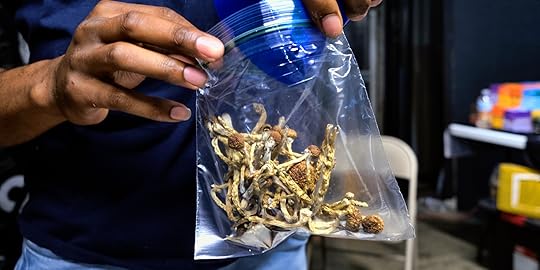
Prem Thakker
The Intercept
A bill to legalize psychedelics is on a trip to California Gov. Gavin Newsom’s office.
On Thursday, the California Senate gave final approval to a bill legalizing certain psychedelics for people who are 21 or older. If Newsom signs the bill, it will go into effect in 2025 and make it legal to possess or grow plant-based psychedelics, including psychedelic mushrooms.
Newsom has not said where he stands on the bill, but he has mostly been a critic against the war on drugs, having been a leading voice to legalize cannabis in California and reduce nonviolent offenses like drug crimes to misdemeanors rather than felonies. Last year, however, he vetoed a bill that would have allowed three California cities to operate supervised drug-consumption sites in efforts to combat fatal overdoses.
“We respect the legislative process and don’t typically comment on pending legislation,” a Newsom spokesperson told Marijuana Moment on Thursday. “The governor will evaluate the bill on its merits when it reaches his desk.”
Veterans are particularly invested in the issue, given mounting research showing how psychedelics can aid in treatments for mental disorders, including post-traumatic stress disorder. “We hope that Governor Newsom agrees that veterans should not be criminalized for seeking healing through psychedelic substances and signs this bill into law,” Jesse Gould, former Army ranger and founder of veterans advocacy group Heroic Hearts Project, told The Intercept in a statement. He added that the U.S. has a long way to go in supporting treatment for military veterans. “We hope that more politicians step up to the plate and back their words of supporting the troops with real action. With the veteran suicide epidemic, veterans do not have the luxury of time to wait.”
Jon Kostas of the Apollo Pact, a group dedicated to making psychedelic-assisted treatments more accessible, argues that going through national avenues like the Food and Drug Administration would prove more effective than legalization in getting psychedelics to those who need it. Kostas was the first participant in a New York University clinical trial treating alcohol use disorder with psilocybin-assisted therapy. He credits the therapy with curing his alcoholism and saving his life.
“If they really want people to get access to it, if they really want to make these therapies affordable, the best way to do this is going through a federal level so insurance covers this,” Kostas said. “I’d love to see Medicare or Medicaid cover this. I’d love to see the VA cover this. And you’re not going to get that by legalizing this for recreational use.”
So far, Colorado and Oregon are the only states that have fully legalized the use of mushrooms. In Congress, Rep. Alexandria Ocasio-Cortez, D-N.Y., introduced an amendment in 2019 to expand research into psychedelics but was shut down by a majority of Democrats and nearly all Republicans. Ocasio-Cortez joined forces with Rep. Dan Crenshaw, R-Texas, last year to attach amendments to the annual military spending bill to increase access to psychedelic treatments to veterans and active service members, as well as to expand research into psychedelic substances. Last summer, the U.S. Department of Veterans Affairs launched a number of clinical trials involving psychedelic drugs, which have shown promise in the treatment of post-traumatic stress disorder.
The California bill names four substances: psilocybin, psilocin, dimethyltryptamine, or DMT, and mescaline.
The bill would decriminalize the use of the substances for noncommercial, personal use, as well as for the purposes of “group community-based healing” and “risk reduction.” The bill directs the state’s health and human services agency to create a working group that would make recommendations about the use of the substances in a therapeutic setting before legalization commences in 2025.
The bill would also allow Californians to plant and harvest an “allowable amount” of the legalized psychedelics: up to 4 grams of mescaline; 1 gram of DMT; and 1 gram of, or up to 1 ounce of a plant or fungi containing, either psilocybin or psilocin.
The bill does include some restrictions: It would make it a misdemeanor for adults to possess psychedelics on school grounds while school is in session and would fine and/or imprison those who knowingly give the substances to minors.
[…]
Via https://theintercept.com/2023/09/08/california-psychedelics-bill/
1215 AD: Why the Fourth Lateran Council Was More Important than the Magna Carta
Episode 5 What Inspired the Fourth Lateran Council
1215: Years That Changed History
Dr Dorsey Armstrong (2019)
Film Review
In this lecture Armstrong makes the case that the 1215 Lateran Council, owing to the pervasive control the Roman Catholic Church had over medieval life, had far more impact than the Magna Carta on the lives of ordinary Europeans. In her view, this relates largely to its role in heralding a new “persecutory” society, ie one in which lepers, women, Jews and Muslims had fewer rights than healthy Christian men. She blames this sociological change on a population boom (triggered initially by a warming climate and greater agricultural productivity) and greater competition for land.
The Lateran Councils were ecumenical gatherings (ie representing all Catholic countries) called by the Vatican to resolve questions of church doctrine. There have been 21 ecumenical councils in all. The last was Vatican 2 (1962-65).
The 325 AD First Council of Nicaea [1] (attended by 1800+ bishops and clerics) was the first ecumenical Council, convened by the Roman emperor Constantine the Great.[2] Its alleged purpose was to resolve the dispute which had arisen in the Church of Alexandria over the true nature of Jesus.
This first council dismissed Arianism (the belief that Jesus wasn’t eternal like God the father, but was created by him and Adoptionism (the belief He was born human and God adopted Him making Him divine) as heresies. The First Council of Nicaea also set out the Nicene Creed (a set of compulsory beliefs for all Christians), devised a method for calculating Easter, banned self-castration, usury and kneeling for prayers (in favor of standing) during Pentecost.
The so-called Lateran Councils were ecumenical councils that took place in the Lateran Palace in Rome.
Lateran 1 (1123) – consolidated doctrine in the western church following the 1054 Great Schism between the Roman Catholic and the Eastern Orthodox church. This council also made decrees about the Pope having sole authority to appoint bishops, the celibacy of priests and the ban on blood relatives marrying.Lateran 2 (1139) – proclaimed Innocent II (in preference to his rival Anacletus II) the true pope.Lateran 3 (1159) – confirmed Alexander III pope (in preference to three “antipopes”), declared Catharism [3] a heresy, prohibited priests from charging fees for blessing marriages and banned Jews and Muslims from hiring Christians as servants.Lateran 4 (1215) – the second and most impactful council (after the First Council of Nicaea), made declarations regarding transubstantiation,[4] the conduct of the Crusades and the treatment of Jews, Muslims, women and Cathars.[1] In modern day Turkey.
[2] It’s believed Constantine called the First Council of Nicaea for political reasons, to increase stability in Rome’s rapidly disintegrating empire. Although he decriminalized Christianity in 313, he was only formally baptized on his deathbed in 327.
[3] The Cathars were a gnostic movement that flourished in southern Europe between the 12th and 14th century. Gnosticism is the belief that all human beings contain a divine spark (a piece of God) within themselves.
[4] According to Roman Catholic and Eastern Orthodox dogma, transubstantiation is a process in which communion bread and wine become the actual body and blood of Christ.
Film can be viewed free with a library card on Kanopy.
September 9, 2023
How 36 Reporters Brought Us the Twin Towers Explosive Demolition on 9/11

Ted Walter and Graeme MacQueen
The widely held belief that the Twin Towers collapsed as a result of the airplane impacts and the resulting fires is, unbeknownst to most people, a revisionist theory. Among individuals who witnessed the event firsthand, the more prevalent hypothesis was that the Twin Towers had been brought down by massive explosions.
This observation was first made 14 years ago in the article, “118 Witnesses: The Firefighters’ Testimony to Explosions in the Twin Towers.” A review of interviews conducted with 503 members of the New York Fire Department (FDNY) in the weeks and months after 9/11 revealed that 118 of them described witnessing what they interpreted that day to be explosions. Only 10 FDNY members were found describing the destruction in ways supportive of the fire-induced collapse hypothesis.
The interviews of fire marshal John Coyle and firefighter Christopher Fenyo explicitly support this finding. Coyle remarked in his interview, “I thought it was exploding, actually. That’s what I thought for hours afterwards. . . . Everybody I think at that point still thought these things were blown up.” Similarly, Fenyo recalled in his interview, “At that point, a debate began to rage [about whether to continue rescue operations in the other, still-standing tower] because the perception was that the building looked like it had been taken out with charges.”
News reporters constitute another group of individuals who witnessed the event firsthand and whose accounts were publicly documented. While many people have seen a smattering of news clips on the internet in which reporters describe explosions, there has never been, as far as we know, a systematic attempt to collect these news clips and analyze them.
We decided to take on this task for two reasons. First, we wanted to know just how prevalent the explosion hypothesis was among reporters. Second, anticipating that this would be the more prevalent hypothesis, we wanted to determine exactly how it was supplanted by the hypothesis of fire-induced collapse.
In this article, we present our findings related to the first question. In a subsequent article, we will examine how the hypothesis of fire-induced collapse so quickly supplanted the originally dominant explosion hypothesis.
Television Coverage CompiledTo determine how prevalent the explosion hypothesis was among reporters, we set out to review as much continuous news coverage as we could find from the major television networks, cable news channels, and local network affiliates covering the events in New York.
Through internet searches, we found continuous news coverage from 11 different television networks, cable news channels, and local network affiliates. These included the networks ABC, CBS, and NBC; cable news channels CNN, Fox News, MSNBC, and CNBC; and local network affiliates WABC, WCBS, and WNBC. We also incorporated coverage from New York One (NY1), a New York-based cable news channel owned by Time Warner (now Spectrum), which we grouped with the local network affiliates into a local channel category.
[…]
The picture that unmistakably emerges is that the great majority of reporters who witnessed the destruction of the Twin Towers either perceived an explosion or perceived the towers as exploding. This hypothesis of the Twin Towers’ destruction then continued to be prevalent among reporters covering the event, who essentially viewed the destruction of the towers as an explosion-based attack subsequent to the airplane strikes.
We learn from the source-based reporting that the same hypothesis was also held by officials in the FDNY, the New York Police Department (NYPD), and the Federal Bureau of Investigation (FBI) — three of the most important agencies involved in the response to the attacks. In particular, with regard to the FBI, we are told the explosion hypothesis was the agency’s “working theory” as of late in the afternoon on 9/11.Unlike members of the FDNY, most of whom provided their accounts during interviews conducted weeks or months after the event, it was the job of reporters to spontaneously communicate their perception and interpretation of events. Thus, when their reporting is compiled into one record, we are left with a rich and largely unfiltered collective account of what took place. Considered alongside the FDNY oral histories, these reporters’ statements, in our view, constitute strong corroborating evidence that explosives were used to destroy the Twin Towers.
Regarding the four non-explosion reporters, in addition to the fact that there are so few of them, we find that their individual accounts add little support to the fire-induced collapse hypothesis.
[…]
Nuclear Energy Not Viable Option for Preventing Global Warming

Antinuclear
According to scenarios from the World Nuclear Association and the OECD Nuclear Energy Agency, doubling the capacity of nuclear power worldwide in 2050 would only decrease greenhouse gas (GHG) emissions by around 4%, yet would require 37 new large nuclear reactors to the grid every year from now until 2050. In other words, nuclear energy delivers too little energy to matter.
Nuclear power plants are too dangerous and leave communities vulnerable. Power plants require some of the most complex set of resources to be ready at all times—this is not guaranteed with the growing climate crisis and resulting extreme weather events that will affect operations. Additionally, nuclear energy is too expensive to be sustainable. It costs on average more than double the cost of other energy alternatives like solar and wind—and those costs continue to increase. The large amounts of waste that is produced by the nuclear fuel cycle is highly radioactive, and will remain so for several thousand years—and yet no government has ever been able to find a way to safely manage it.
https://www.indigenousclimateaction.com/entries/nuclear-dump-threatens-kichi-sibi
Via https://antinuclear.net/2023/09/08/nuclear-energy-is-not-a-viable-option/
Natural Immunity 27 Times Than Covid Vaccine
Dr. John Campbell
Natural Immunity 27 Times Better For Protection Of Virus
Severe Acute Respiratory Syndrome Coronavirus 2 (SARS-CoV-2) Naturally Acquired Immunity versus Vaccine-induced Immunity, Reinfections versus Breakthrough Infections: A Retrospective Cohort Study.
Abstract
Background
Waning of protection against infection with severe acute respiratory syndrome coronavirus 2 (SARS-CoV-2) conferred by 2 doses of the BNT162b2 vaccine begins shortly after inoculation and becomes substantial within 4 months. With that, the impact of prior infection on incident SARS-CoV-2 reinfection is unclear. Therefore, we examined the long-term protection of naturally acquired immunity (protection conferred by previous infection) compared to vaccine-induced immunity.
Methods
A retrospective observational study of 124 500 persons, compared 2 groups: (1) SARS-CoV-2-naive individuals who received a 2-dose regimen of the BioNTech/Pfizer mRNA BNT162b2 vaccine, and (2) previously infected individuals who have not been vaccinated. Two multivariate logistic regression models were applied, evaluating four SARS-CoV-2-related outcomes—infection, symptomatic disease (coronavirus disease 2019 [COVID-19]), hospitalization, and death—between 1 June and 14 August 2021, when the Delta variant was dominant in Israel.
Results
SARS-CoV-2-naive vaccinees had a 13.06-fold (95% confidence interval [CI], 8.08–21.11) increased risk for breakthrough infection with the Delta variant compared to unvaccinated-previously-infected individuals, when the first event (infection or vaccination) occurred during January and February of 2021. The increased risk was significant for symptomatic disease as well. When allowing the infection to occur at any time between March 2020 and February 2021, evidence of waning naturally acquired immunity was demonstrated, although SARS-CoV-2 naive vaccinees still had a 5.96-fold (95% CI: 4.85–7.33) increased risk for breakthrough infection and a 7.13-fold (95% CI: 5.51–9.21) increased risk for symptomatic disease.
Conclusions
Naturally acquired immunity confers stronger protection against infection and symptomatic disease caused by the Delta variant of SARS-CoV-2, compared to the BNT162b2 2-dose vaccine-indued immunity.
READ MORE: https://academic.oup.com/cid/article/75/1/e545/6563799
Via https://rightsfreedoms.wordpress.com/2023/09/07/natural-immunity-wins/
The Most Revolutionary Act
- Stuart Jeanne Bramhall's profile
- 11 followers




